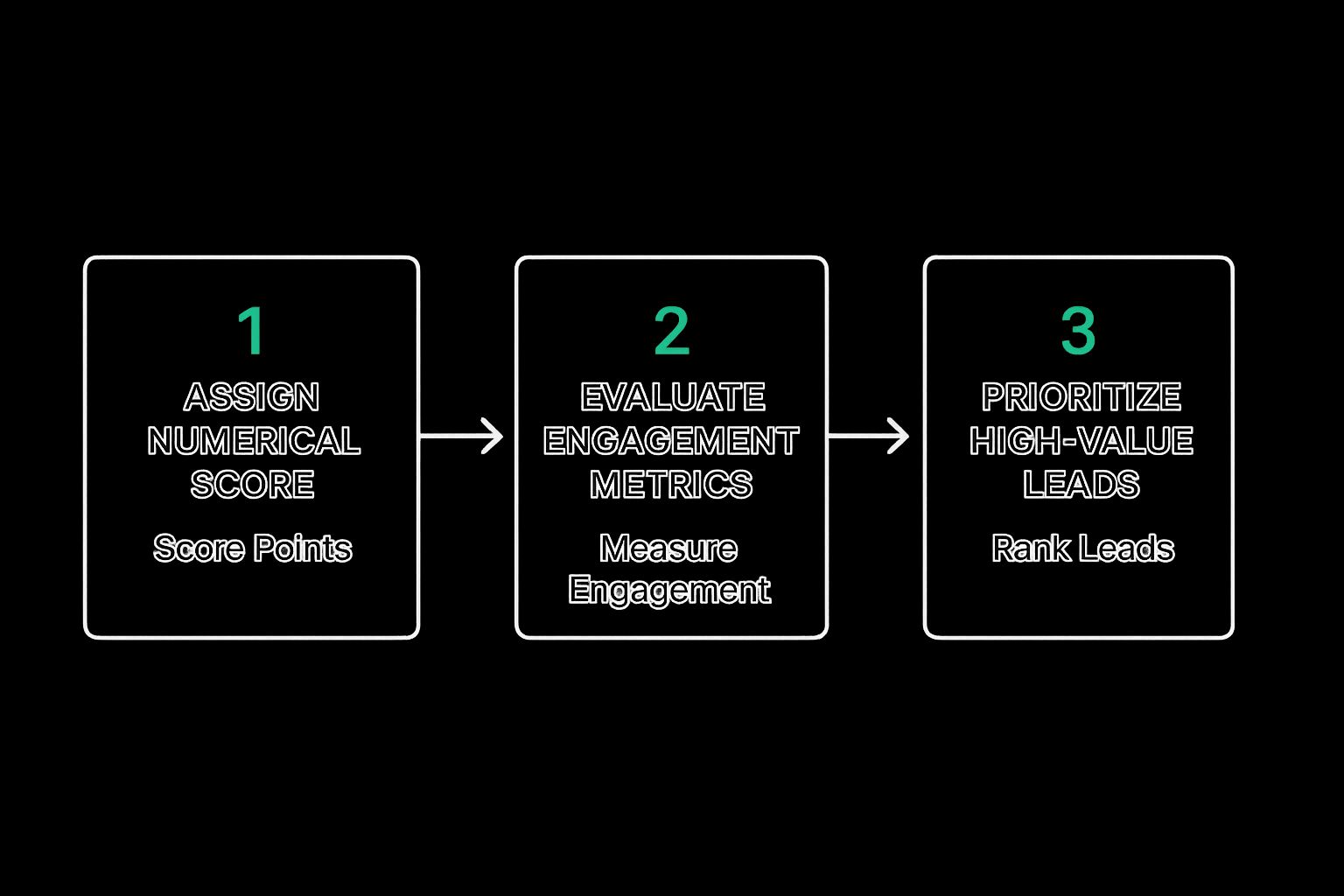How to Qualify Sales Leads: Boost Your Conversion Rates
Let's be honest, the biggest drain on any sales team is chasing leads that go nowhere. It's a classic sales pitfall. The real secret to how to qualify sales leads isn't about chasing every single inquiry that comes through the door. It's about building a smart, systematic way to spot the prospects who have a genuine need, the authority to make a decision, and are showing clear signs they're ready to buy.
This is about building a framework that filters out the noise and puts the real opportunities front and center.
Stop Guessing and Start Qualifying Leads Intelligently

What really separates the top-performing sales teams from everyone else? A rock-solid qualification process. This guide is designed to move you past the outdated BANT acronyms and into a modern framework that blends sharp criteria with real, observable buyer intent. The goal here isn't just theory; it's to build a repeatable system that brings total clarity to your pipeline.
It’s kind of shocking, but even with all the sales tech out there, lead qualification is still a massive headache for most sellers. In fact, some studies show that up to 55% of leads are completely neglected simply because there's no systematic follow-up process in place. That's a huge gap between effort and results—a gap that a structured approach closes for good.
This guide will walk you through the core pillars of a modern qualification strategy, giving you a clear roadmap to follow. We’re going to cover:
- Defining criteria: How to move beyond basic demographics to understand what a true fit actually looks like for your business.
- Identifying intent: Learning to spot the digital breadcrumbs that signal a buyer is getting serious.
- Scoring and prioritizing: Creating a simple, effective system to focus your team’s energy where it counts the most.
To get a jumpstart on moving beyond guesswork, you might think about leveraging a sales qualifier chatbot for a more precise and efficient way to assess prospects. It’s a great way to automate that initial screening, freeing up your team to do what they do best: have high-value conversations.
Before we dive in, let’s look at the big picture. A modern lead qualification framework is built on a few key pillars that work together to create a smooth, predictable pipeline.
The Modern Lead Qualification Framework at a Glance
| Framework Pillar | Key Objective | Primary Benefit |
|---|---|---|
| Ideal Customer Profile (ICP) | Define the perfect-fit company and buyer persona. | Ensures you're targeting the right market segment. |
| Intent Signal Identification | Pinpoint behaviors that show active buying interest. | Focuses efforts on leads who are ready to talk now. |
| Lead Scoring System | Quantify and rank leads based on fit and intent. | Creates a clear priority list for the sales team. |
| Systematic Follow-Up | Implement a consistent process for engaging qualified leads. | Prevents high-potential leads from falling through the cracks. |
This table sums up the core components. When these elements are in sync, you stop wasting time on dead-end leads and start accelerating deals with prospects who are genuinely ready to solve their problem with your solution. Now, let’s get into the specifics of how to build this for your team.
Define Your Ideal Customer Profile with Precision

Before you can spot a qualified lead, you need a rock-solid idea of who you're actually selling to. The bedrock of any smart qualification process isn't some trendy acronym—it's a carefully constructed Ideal Customer Profile (ICP). This is more than just a list of industries; it’s a data-backed blueprint of your perfect customer.
Your best starting point is your existing customer base. Take a hard look at your most successful accounts. I’m talking about the ones with high lifetime value, quick sales cycles, and the ones who basically act as your cheerleaders. What do they all have in common?
Your best customers aren't just the ones who spend the most; they're the ones who get the most value from your solution. Their success is a roadmap to finding your next great customer.
Once you’ve got that group identified, it's time to dig into the details and find the patterns. A truly powerful ICP goes way beyond surface-level stuff and pulls together multiple layers of data.
Digging into the Data
To build an ICP you can actually use, you need to collect and analyze the specific attributes that define these best-fit accounts. This whole exercise is about turning gut feelings into concrete, actionable criteria. Let’s break it down into a few key areas.
First up is firmographic data. This is the basic organizational DNA of a company:
- Company Size: How many employees are on their payroll?
- Industry: Which specific verticals are they in?
- Revenue: What’s their annual revenue look like?
- Geography: Where are their headquarters or main offices?
Next, you'll want to layer on technographic data. This is a goldmine. It tells you what tech stack a company is using, which is often a massive clue about their operational maturity and whether they're a good fit for your solution. For example, are your best customers all using a specific CRM or marketing automation platform? That’s a huge qualifying signal.
For anyone new to this whole process, getting the fundamentals right is key. Our beginner's guide to B2B lead generation is a great place to get your bearings: https://intently.ai/blog/beginners-guide-to-b2b-lead-generation
Finally, you need to document the behavioral signals that scream "I'm interested!" These are the actions that show a prospect is shifting from just kicking tires to seriously evaluating solutions.
- Did they download a specific, high-value case study?
- Have they been back to your pricing page a few times this week?
- Are they clicking on your competitor comparison content?
When you combine firmographic, technographic, and behavioral data, you get a dynamic, three-dimensional profile. This ICP becomes the single source of truth for your marketing and sales teams, making sure everyone is rowing in the same direction. Getting this alignment right is the first—and most important—step toward building a predictable revenue engine.
Build a Practical Lead Scoring System
Once you've nailed down your Ideal Customer Profile (ICP), it's time to turn that definition into a real-world prioritization tool. This is where a lead scoring system comes into play. It sounds technical, but it’s really just a way to assign points to leads based on who they are and what they do, so you can rank how ready they are to talk to sales.
This whole process turns a chaotic inbox into a clean, prioritized list. For example, a director from one of your target industries who just checked out your pricing page? That's a hot lead, maybe worth 25 points. On the other hand, an intern who only downloaded a top-of-funnel ebook might just get 5 points.
The idea is to set clear thresholds. A lead hitting 50 points, for instance, could become a Marketing-Qualified Lead (MQL) and get dropped into a nurture campaign. Once they hit 100 points, they’re a Sales-Qualified Lead (SQL), and an alert goes straight to a sales rep for immediate follow-up.
Assigning Points That Matter
The trick is to give more weight to signals that strongly suggest someone is ready to buy. You don't need to overcomplicate it. Just start with a simple scale and assign points across two main buckets: explicit data (who they are) and implicit data (what they do).
Explicit Data (Fit): This is the information the lead gives you directly.
- Job Title: C-Level/VP (+20), Director (+15), Manager (+10)
- Company Size: Matches your ICP sweet spot (+15)
- Industry: Falls into a target vertical (+10)
Implicit Data (Interest): These are the behavioral breadcrumbs you track.
- High-Intent Pages: Views on pricing or demo pages (+25)
- Content Engagement: Downloads a case study (+15)
- Email Interaction: Clicks a link in an email (+5)
This graphic gives you a quick visual of how scoring helps rank leads so your team can act effectively.

By scoring both fit and engagement, you can quickly stack-rank your prospects and make sure your sales team is always focused on the best opportunities first.
Why Scoring Is a Game-Changer
Putting a system like this in place has a real, measurable impact. Before we get into the "how," let's talk about the "why." Without a system, sales reps are essentially guessing which leads to call first, often chasing whoever came in last. With scoring, they're working from a prioritized list based on actual buying signals.
This simple table shows the difference it makes.
Lead Management With vs Without Scoring
| Metric | Without Lead Scoring | With Lead Scoring |
|---|---|---|
| Sales Focus | Scattered, often "last-in, first-out" | Prioritized on high-intent leads |
| Lead Quality | Inconsistent, mixed bag | Consistently high-quality leads |
| MQL-to-SQL Rate | Low, lots of unqualified leads | Significantly higher conversion rate |
| Sales Efficiency | Wasted time on cold leads | Reps focus on winnable deals |
| Forecast Accuracy | Unpredictable, hard to forecast | More predictable pipeline |
| Sales & Marketing | Often misaligned on lead quality | Aligned with a common definition |
As you can see, the difference is stark. It's about working smarter, not just harder.
The numbers back this up, too. Data shows that companies using structured qualification and lead scoring close 30% of their SQLs. That’s a huge jump from the 20% close rate for teams without a system. Despite this, only 44% of organizations globally are even using lead scoring. If you want to dive deeper, you can discover more insights about lead generation statistics and see how top performers are getting ahead.
A lead scoring system isn't just about numbers; it's about creating alignment between marketing and sales. It provides a common language to define what a "good lead" truly means, ending the debate once and for all.
Ultimately, this system gives your reps their time back, letting them focus on conversations that are actually likely to convert. It brings a sense of predictability to your pipeline and ensures those high-potential leads never slip through the cracks because of a disorganized follow-up process. It’s a foundational piece for building a sales engine that can truly scale.
Use High-Intent Signals to Time Your Outreach
Perfect timing can be the difference between a great sales conversation and a closed deal. While lead scoring gives you a general sense of priority, high-intent signals are the digital breadcrumbs that tell you a prospect is shifting from casual research to a serious buying evaluation. This is how you move from just following up to a proactive, intent-driven strategy.
Instead of only tracking form fills, you need to be watching for the actions that signal genuine curiosity and urgency. These behaviors are far more valuable because they tell you what a prospect is thinking right now. A lead isn't just a score; they're a person trying to solve a problem.
Spotting High-Value Actions
So, what do these signals look like in the real world? They're often subtle but incredibly revealing. Your job is to connect these dots to see the bigger picture of their buying journey.
Look for patterns like these:
- Repeated visits to key pages: A prospect hitting your pricing or case study pages multiple times in a single week is a massive indicator of interest.
- Engagement with comparison content: If someone downloads your competitor comparison guide, you know they're actively weighing their options.
- Exploring technical documentation: A lead browsing your integrations or API documentation is almost certainly evaluating how your solution would fit into their existing tech stack.
These actions go way beyond a simple ebook download. They show a deeper level of engagement and suggest the prospect is trying to answer specific, bottom-of-the-funnel questions. For teams looking to automate this discovery process, exploring the complete guide to AI lead generation tools can show you how technology surfaces these signals automatically.
The goal isn't just to find interested leads; it's to find leads who are interested today. High-intent signals close the gap between potential interest and immediate opportunity.
By setting up alerts for these specific behaviors, you give your sales team the power to act at the precise moment a prospect is most engaged. When a lead views your demo video for the second time, an immediate, relevant outreach call from a rep is worlds more effective than a generic email sent three days later. This timely approach is a cornerstone of modern sales qualification.
Why Speed Is Your Secret Weapon in Lead Response

You can have the most perfectly scored, ideal-fit prospect in the world, but if your follow-up is slow, you’ve already lost. When it comes to lead qualification, speed isn’t just a nice-to-have—it’s everything. A lead's interest has an incredibly short half-life. With every minute you wait, their enthusiasm and intent fade away.
The data on this is staggering. Companies that reach out to leads within 5 minutes see a 10x higher qualification rate. Wait just 10 minutes, and that rate plummets by a shocking 400%. Yet, so many businesses still struggle to act fast. You can read the full research on sales statistics to see just how critical timing is.
What this really means is that you have to capitalize on that peak moment of interest. It's a race to turn a qualified lead into a real conversation before your competitors get there first.
Implementing the 5-Minute Rule
Making speed a priority requires a system, not just good intentions. The goal is to shrink the gap between the moment a lead shows interest and the second your team makes that first touch.
Here are a few practical ways to get it done:
- Automate Lead Routing: Instantly send inbound leads to the right sales rep based on territory, industry, or whatever rules make sense for your team. No more manual assignments that create delays.
- Leverage Chat: Use live chat or an AI chatbot on your site. This lets you engage visitors in real-time, answer their initial questions, and even book demos on the spot.
- Use Personalized Templates: Keep ready-to-go, yet easily customizable, email templates for that first touchpoint. This cuts down on writing time while still allowing for a personal touch.
The "5-minute rule" isn't about being pushy; it's about being present. You're simply meeting the buyer's enthusiasm with your own, right when their interest is at its absolute highest.
This approach transforms your follow-up from a reactive chore into a proactive advantage, and it directly impacts your ability to qualify sales leads. This is especially vital today when old-school outreach methods are failing. You can explore more on this topic by understanding why cold outreach doesn't work anymore.
Still Have Questions About Qualifying Sales Leads?
Even with a solid plan, a few questions always pop up when you're dialing in your lead qualification process. Let's tackle some of the most common ones to clear up any confusion and get you past those typical hurdles.
Lots of sales pros want to know exactly what makes a lead qualified and truly ready for a conversation. Getting the different stages straight is the first step.
Getting the Lingo Straight
First things first, let's quickly decode the acronyms that get thrown around all the time.
MQL (Marketing-Qualified Lead): Think of this as someone who raised their hand. They downloaded an ebook, signed up for a webinar, or did something else to show interest. They’re a potential fit, but they aren't necessarily waiting by the phone for a sales call.
SQL (Sales-Qualified Lead): Now we're talking. An SQL has been properly vetted by the sales team and checks all the important boxes. They've shown real intent and look a lot like your ideal customer.
PQL (Product-Qualified Lead): These are often the best leads you can get. A PQL has shown serious buying intent by actively using your product, usually in a free trial or on a freemium plan. Their actions inside the product are a massive signal that they see its value.
How Often Should I Revisit My Qualification Criteria?
Your lead qualification rules should never be set in stone. The market changes, your product evolves, and so should your criteria.
Make it a point to review your entire framework at least every six months. You’ll also want to take a fresh look anytime your business goes through a big shift—like launching a new product, breaking into a different market, or if you start noticing your win rates are slipping.
A regular check-in that includes both sales and marketing is non-negotiable. It’s the only way to make sure your criteria stay perfectly synced with your ideal customer, what’s happening in the market, and your company's big-picture goals.
Can a Small Business Score Leads Without Fancy Software?
Absolutely. While specialized software can definitely automate and scale things up, a small business can get started with a simple spreadsheet. It's easier than you think.
Just create columns for your main criteria (things like job title, company size, or specific website pages they visited) and assign points to each one. You could even use your CRM’s tagging features to keep a running tally. The most important thing is to start with a system that's simple and that your team can use consistently.
Ready to stop guessing and start finding high-intent leads? Intently uses AI to monitor social channels for conversations from prospects actively looking for solutions like yours. Get real-time alerts and engage with qualified leads before your competition does. Learn more at https://intently.ai.
